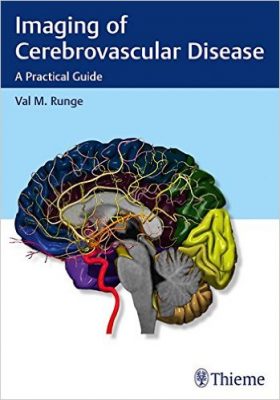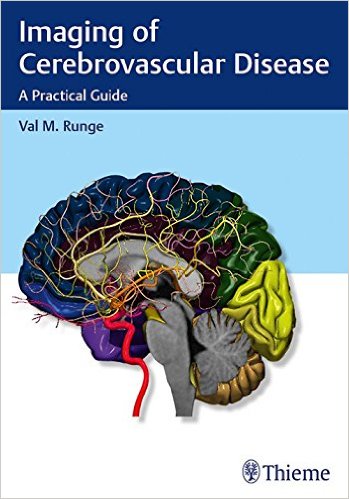 Author and Editor: Val M. Runge, MD
Author and Editor: Val M. Runge, MD
Publisher: Thieme – 145 pages
Book Review by: Nano Khilnani
This book by Dr. Val Runge, who has authored 16 books, is meant for trainees such as residents and fellows in neurology, neurosurgery, and radiology. It is a good resource to prepare for board exams and get certification and recertifications. It is also useful for attending physicians in these specialties.
It well rounds out two of his other books: The Physics of Clinical MR Taught Through Images and Essentials of Clinical MR
With its focus on cerebrovascular disease, this work looks deeper into abnormalities in this area, showing particular conditions by presenting lots of images and analyzing them. The images are of three basic types: computed tomography or CT, digital subtraction angiography or DSA, and magnetic resonance or MR.
Deeper looks into conditions, such as in-depth analysis and discussions, are provided for example, in chapter 5 – Aneurysms, as the Foreword writer Dr. William G. Bradley Jr., (Professor and Chairman of the Department of Radiology at the University of California in San Diego) points out. Dr. Runge writes about treatment here with surgery by clipping, and by endovascular techniques such as coiling and flow diversion. He also points out the advantages and disadvantages of these techniques in terms of morbidity and mortality.
This compact book of less than 150 pages covers the following areas in six chapters:
- Technologic Innovations in Magnetic Resonance (MR) and Computed Tomography (CT)
- Normal Anatomy
- Hemorrhage
- Ischemia
- Aneurysms
- Vascular Malformations and Other Vascular Lesions
Dr. Runge suggests that this book be read from cover to cover, as well as kept as a reference manual for use in the course of a busy day of learning and practice. It also serves as a supplement to basic neuroradiology texts.
He writes from a clinical imaging perspective, drawing on his personal experiences as well as educational resources.
Materials in the chapters are simply organized by topics. For example in chapter 1, Technologic Innovations in MR and CT, the topics and subtopics, after the Introduction, are:
Magnetic Resonance
- Spatial Resolution
- Slice Thickness
- Brain Screening
- Contrast Media
- 3D Time of Flight MRA
- Diffusion Weighted Imaging
- Further Caveats
- Perfusion Imaging
Computed Tomography
- Dual Energy
- Iterative Reconstruction
- Low Peak Knowledge
- Perfusion Imaging
- Radiation Dose Reduction
- New and Innovative Applications
Summary
This is a compact, excellent, and practical book on how to image and interpret numerous cerebrovascular diseases. The author and editor Dr. Val Runge has wide experience, having written extensively in books on the subject.
Author and Editor:
Val M. Runge, MD is Editor-in-Chief of the journal Investigative Radiology, and is a Faculty member at the Institute for Diagnostic, Interventional, and Pediatric Radiology, in Inselspital, at the University of Bern in Bern, Switzerland.
Contributors:
Prof. Dr. Wieslaw L. Nowinski, DSc., PhD is Founding Director of the Center for Virtual Anatomy and Surgical Simulation at Cardinal Stefan Wyszynski University in Warsaw, Poland.
Rudiger von Ritschl, MD is Director of Neuroimaging at Superior Imaging in Windsor, Ontario, Canada.







